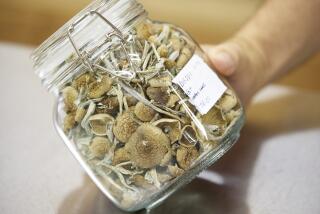Bastyr University Aims to Meld Traditional With ‘Natural’ Medicine
SEATTLE — For Bastyr University, naturopathy has led to the good life.
It’s not the school’s fragrant herb garden or the tasty whole-wheat scones served in its cafeteria. It’s rising attendance and even funding from the federal government.
Once dismissed as a fringe-culture fad, naturopathy is drawing a growing legion of followers.
“I think it’s a combination of just more awareness of natural medicine and a growing awareness that orthodox medicine doesn’t have all the answers,” said Jane Guiltinan, chief medical officer for Bastyr’s Natural Health Clinic, which logs about 25,000 patient visits annually.
The school was founded in 1978 to train naturopaths, who diagnose and treat illness with natural remedies and a focus on the well-being of the whole person. It was named for John Bastyr, a regional pioneer in the field who died last June.
The university has flourished over the years. Enrollment has increased so dramatically--from 31 students the first year to more than 900 today--that it is moving out of the dreary, cramped former elementary-school building it leases to a new home four times the size.
Its new 186,000-square-foot campus scheduled to open this year will be located on nearly 50 acres of woods, fields and trails on the northeast shore of Lake Washington.
“This move signifies a coming of age for Bastyr University,” said school president and co-founder Joseph Pizzorno Jr. “It is more than just a change of location.”
Pizzorno was a naturopath in private practice when he and two other Bastyr students, William Mitchell and Les Griffith, decided to start a school in hopes of bringing science-based natural medicine into the mainstream.
There were no comprehensive textbooks available then. Accrediting agencies kept their distance. The foundations that dispensed health-research grants were dominated by doctors who frowned on alternative health care.
“There was nothing,” Pizzorno recalls. “There were no resources, no possibility of resources. All there was were a dedicated few people who wanted to make it happen.”
The trio leased a one-room office and lab space from a nearby community college and set up the John Bastyr College of Naturopathic Medicine. They used a $200 donation from one of Pizzorno’s patients to print brochures and catalogs. Today, Bastyr University has an annual operating budget of $6 million, an endowment of $500,000 and a faculty of 125.
Bastyr students go through four years of schooling to get an N.D., a doctor of naturopathy degree. They take many of the courses required of medical students--anatomy, physiology and biochemistry, for example--in addition to courses in areas such as massage, midwifery, homeopathy and Chinese herbal medicine.
Bastyr and the National College of Naturopathic Medicine in Portland, Ore., are the only two nationally accredited natural-medicine colleges in the United States. A third school, Southwest College of Naturopathic Medicine in Scottsdale, Ariz., is a candidate for accreditation.
In 1994, the National Institutes of Health awarded Bastyr a landmark $840,000, three-year grant to study alternative-medicine treatment for AIDS.
“There was tough competition for those grants,” Jim Bryant, spokesman for the NIH alternative medicine branch, said at the time.
Bastyr beat out applications from schools such as Harvard and Columbia.
The growing acceptance of alternative medicine is reflected in the marketplace as well.
A study by Dr. David Eisenberg of Beth Israel Hospital in Boston, published in the New England Journal of Medicine in 1993, found that 34% of Americans spent a total of $10.3 billion on alternative care in 1990.
More than 60 insurance companies, unions and state organizations nationwide have covered treatment by a naturopathic doctor, according to the Seattle-based American Assn. of Naturopathic Physicians. And many others have covered some aspect of alternative care, such as acupuncture or a chiropractor.
Most large insurance plans, however, still do not cover visits to a naturopath, and Pizzorno sees that as the biggest obstacle to patient access to naturopaths.
The American Medical Assn. doesn’t take a formal stand on naturopathy.
“We don’t spend our time beating up on non-M.D.s,” said Tom Curry, executive director of the Washington State Medical Assn.
“Our position is that naturopaths and their claims of efficacy ought to be held to the same scientific standards as . . . traditional medicine,” Curry said.
Eight states license naturopathic doctors: Washington, Oregon, Arizona, Montana, Alaska, Hawaii, Connecticut and New Hampshire. Unlike medical doctors, they can’t prescribe most drugs or perform major surgery.
Most of the nation’s 1,400 licensed or license-eligible naturopathic doctors have gotten their degrees in the last 20 years at Bastyr or National.
Kim Disisto Furtado, a 23-year-old Bound Brook, N.J., native, had graduated from George Washington University and was considering medical schools when she read about Bastyr.
“This kind of medicine just clicked inside of me, saying, ‘This is what’s right, this is what I should be doing--non-harmful, natural care for people who have problems that aren’t getting answers,’ ” said Furtado, a first-year student in Bastyr’s program.
More to Read
Sign up for Essential California
The most important California stories and recommendations in your inbox every morning.
You may occasionally receive promotional content from the Los Angeles Times.










